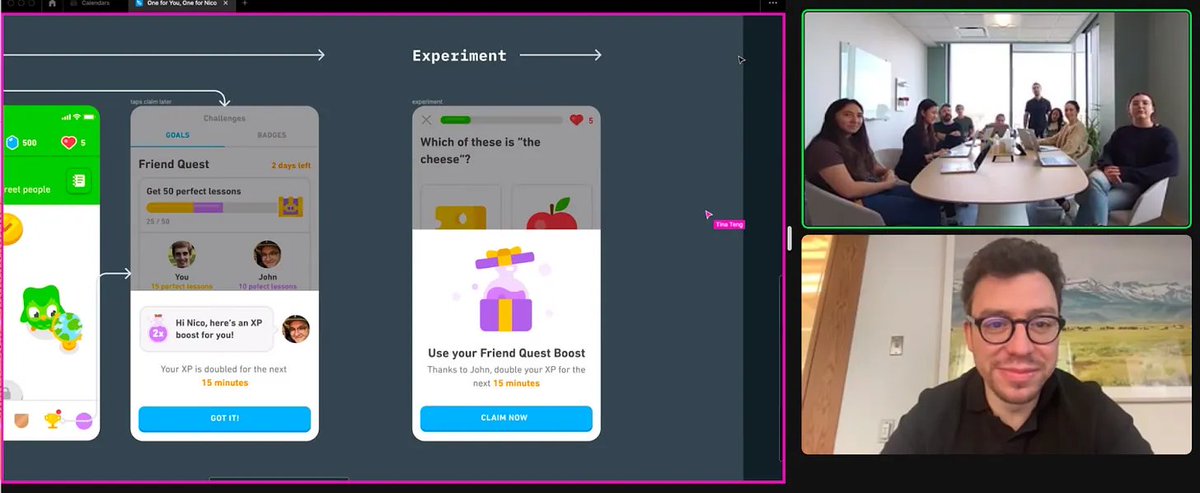Inside Look at Duolingo's Product Development
Learn about Duolingo's unique organizational structure, design review process, OKR cadence, resource allocation system, and more.

Lenny Rachitsky
👋 Newsletter https://t.co/LF0tRFp4pl | Podcast: https://t.co/ZQWNT0ipGb | Jobs: https://t.co/h5qbpego8F | Investing: https://t.co/tLghMwfwmW

-
A glimpse into the inner workings of how @duolingo builds product—including their unique org structure, design review process, OKR cadence, resource allocation system, team rituals, tool stack, goals, and more: pic.twitter.com/pl7T9oU9OW
— Lenny Rachitsky (@lennysan) March 21, 2023 -
1/ Product teams are managed by 2-3 “co-leads”
— Lenny Rachitsky (@lennysan) March 21, 2023
Typically, a PM lead and an Engineering lead head up the team, sometimes joined by a Learning and Curriculum lead (experts in learning science, curriculum design, and educational content creation), Biz Ops lead, or Marketing lead. -
Team co-leads are responsible for their team’s success and roadmap. They also own the decisions in their domain. For example, the PM co-lead owns more of the product discovery/roadmap decisions, whereas the eng lead owns more of the product delivery and implementation decisions.
— Lenny Rachitsky (@lennysan) March 21, 2023 -
2/ All Product teams are part of “areas”
— Lenny Rachitsky (@lennysan) March 21, 2023
An area is a group of product teams that share common business goals. Similar to individual teams, areas also have cross-functional co-leads (Engineering, PM, and other roles, like Marketing). pic.twitter.com/LbVPmVDdR8 -
3/ Product teams are designated as either (1) metric-based or (2) feature-based.
— Lenny Rachitsky (@lennysan) March 21, 2023
Metric-based teams are structured around clear metrics that impact something the company wants to improve, like revenue or DAUs. For example pic.twitter.com/LxqqU1EHp3 -
Feature-based teams are defined by the product problem we want to solve, and in most cases there isn’t a good metric that can accurately quantify success. For example: pic.twitter.com/kOXFaqsvPu
— Lenny Rachitsky (@lennysan) March 21, 2023 -
4/ Reporting structure
— Lenny Rachitsky (@lennysan) March 21, 2023
Here’s a chart that displays what it looks like for PMs on the retention team, which is part of the growth area: pic.twitter.com/4eavMQClsx -
5/ Planning cadence is quarterly, and yearly
— Lenny Rachitsky (@lennysan) March 21, 2023
Quarterly, ther's a three-step process that takes about three weeks. Here’s an example of what the planning cycle for Q2 would look like: pic.twitter.com/FZzvzda0e0 -
For the yearly OKR process, around October each year the senior leadership team comes together to set the company OKRs for the next calendar year. The yearly company OKRs define our biggest strategic bets and highest-priority investments for the next year.
— Lenny Rachitsky (@lennysan) March 21, 2023 -
Here is an example screenshot of what our company OKRs looked like for 2022 for DAU growth (numbers are X’ed out): pic.twitter.com/bC40crxiSs
— Lenny Rachitsky (@lennysan) March 21, 2023 -
6/ Product reviews
— Lenny Rachitsky (@lennysan) March 21, 2023
There's a process internally called “product review” (PR) by which they review and approve larger changes to Duolingo products. Product review meetings happen every Tuesday and Thursday for a total of two hours. -
These two hours are divided into 20-minute slots that product teams sign up to present. The agenda of these meetings is product teams presenting their proposed product changes for the first 5-10m and then reviewers asking questions and giving feedback for the rest of the time.
— Lenny Rachitsky (@lennysan) March 21, 2023 -
Product reviews can happen at different stages of the product life cycle, and they have different types of product review discussions depending on the stage of the project.
— Lenny Rachitsky (@lennysan) March 21, 2023
The one-pager step describes a potential feature idea or product change at the concept level. pic.twitter.com/fr9z8L4SqB -
At the spec stage, you get approval on a fully fleshed-out proposed change.
— Lenny Rachitsky (@lennysan) March 21, 2023
In it, mocks need to be pixel-perfect and copy needs to be word-perfect. The spec should perfectly represent what users will see in the product. Here’s an example spec to show this in action: pic.twitter.com/WzK3Ba75KF -
For more, including example OKRs, how their product/design review meetings work, 1-pager templates, resource allocation, and much more, don't miss the full post 👇https://t.co/GltbuTq488
— Lenny Rachitsky (@lennysan) March 21, 2023 -
Huge huge thank you to @cemkansu for sharing all of this incredible insight with us 🙏
— Lenny Rachitsky (@lennysan) March 21, 2023
